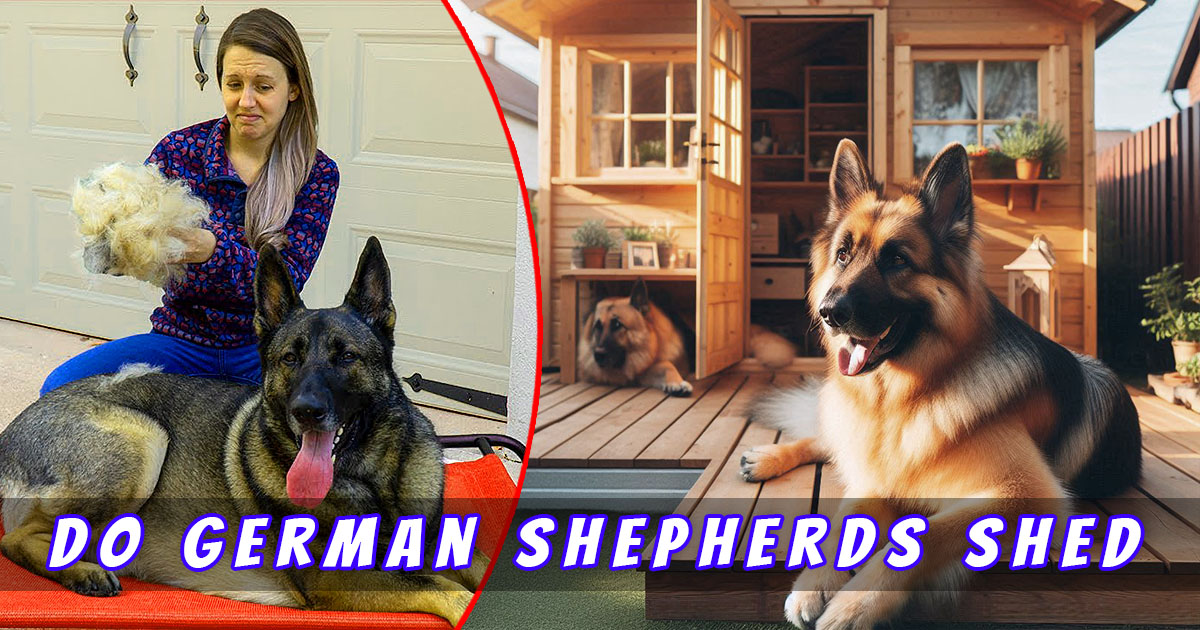If you’re considering getting a German Shepherd or already have one, a common question that arises is, “do German Shepherds shed?” The short answer is yes, they do—and quite a lot. In fact, shedding is a natural and inevitable part of owning this breed. However, with the right knowledge, you can manage it effectively. Here, we’ll explore 10 essential facts about German Shepherd shedding and provide helpful tips to keep it under control.
1. Yes, German Shepherds Shed Year-Round
German Shepherds are known for their thick double coat, which makes them prone to shedding throughout the year. Unlike some breeds, which shed seasonally, German Shepherds shed consistently. However, the shedding intensifies during certain times of the year.
2. Seasonal Shedding is a Real Thing
While German Shepherds shed year-round, their shedding peaks during spring and fall. This process, known as “blowing their coat,” happens when they shed their undercoat to prepare for the changing seasons. If you’ve noticed your German Shepherd shedding more than usual during these times, it’s completely normal.
3. Their Double Coat Protects Them
German Shepherds have a double coat that consists of a soft, dense undercoat and a coarser outer coat. This coat serves a purpose: it protects them from harsh weather conditions. However, this double coat is also why they shed more than single-coated dogs.
4. Shedding Can Vary by Dog
Not all German Shepherds shed the same amount. Factors like age, genetics, diet, and overall health can affect how much a German Shepherd sheds. Some may shed more heavily, while others might shed less.
5. Regular Grooming Helps Manage Shedding
One of the best ways to manage German Shepherd shedding is through regular grooming. Brushing your dog’s coat at least a few times a week helps remove loose hair and prevents it from spreading all over your house.
6. Shedding Can Be Managed with the Right Tools
Using the right grooming tools can make all the difference. Best tools for German Shepherd shedding include deshedding brushes, undercoat rakes, and grooming gloves. These tools are designed to reach the undercoat and remove loose hair effectively.
7. Diet Affects Shedding
Believe it or not, your dog’s diet plays a significant role in how much they shed. A balanced diet rich in Omega-3 and Omega-6 fatty acids can promote a healthy coat and reduce excessive shedding.
8. Regular Baths Help Reduce Shedding
Bathing your German Shepherd with a deshedding shampoo can help loosen dead hair and reduce shedding. It’s essential to use a dog-friendly shampoo that doesn’t strip the natural oils from their coat.
9. Stress and Shedding are Linked
Just like humans, dogs can experience stress, and this can affect their coat. High levels of stress can lead to increased shedding. Keeping your German Shepherd calm and relaxed can minimize shedding.
10. Excessive Shedding May Be a Sign of Health Issues
While shedding is normal, excessive German Shepherd shedding can sometimes be a sign of underlying health problems, such as allergies, skin infections, or hormonal imbalances. If you notice excessive shedding accompanied by bald patches or irritated skin, it’s best to consult a vet.
Why Do German Shepherds Shed So Much? Understanding Their Coat
Now that you know German Shepherds are heavy shedders, you might wonder, “why do German Shepherds shed so much?” The answer lies in their unique coat structure.
Double Coat Explained
German Shepherds have a double coat—a soft undercoat for insulation and a tougher outer coat for protection against the elements. This combination helps them stay warm in the winter and cool in the summer. However, it also leads to a lot of shedding, particularly during seasonal changes when their coat adapts to the weather.
Shedding for Temperature Regulation
German Shepherds shed their undercoat during spring to stay cool during the warmer months. In the fall, they shed their lighter summer coat to grow a thicker winter coat. This natural shedding cycle helps them regulate their body temperature.
Shedding and Genetics
Shedding is also influenced by genetics. German Shepherds were originally bred to work outdoors, which means they needed a coat that could adapt to different environments. As a result, the breed developed a thick, shedding coat.
How Often Do German Shepherds Shed? Seasonal Changes Explained
So, how often do German Shepherds shed? The short answer is all the time, but with some peaks and troughs depending on the season.
Year-Round Shedding
German Shepherds shed continuously throughout the year, but their shedding increases during specific seasons—namely, spring and fall.
Blowing Their Coat in Spring and Fall
During spring and fall, German Shepherds experience what’s called “blowing their coat.” In the spring, they shed their winter undercoat to make way for a lighter coat suited for warmer weather. In the fall, they shed their summer coat to grow a thicker winter coat. This shedding period can last several weeks, so you’ll need to stay on top of grooming during these times.
How to Manage German Shepherd Shedding: Tips and Tricks
Shedding is an inevitable part of owning a German Shepherd, but there are ways to manage it. Here are some effective tips on how to manage German Shepherd shedding.
1. Brush Regularly
Regular brushing is key to managing German Shepherd shedding. Ideally, you should brush your dog’s coat at least three to four times a week, but during shedding season, daily brushing may be necessary. Use a deshedding tool that can reach the undercoat.
2. Use a Deshedding Shampoo
Bathing your German Shepherd with a deshedding shampoo can help remove loose hair and reduce shedding. These shampoos are specially formulated to promote healthy skin and coat.
3. Keep Your Dog Hydrated
Dehydration can lead to dry skin, which increases shedding. Make sure your German Shepherd has access to plenty of water to maintain healthy skin and coat.
4. Ensure a Balanced Diet
A diet rich in Omega-3 and Omega-6 fatty acids promotes a healthy coat and can reduce shedding. Consider adding fish oil or flaxseed to your dog’s diet to improve coat health.
Best Tools for Managing German Shepherd Shedding
When it comes to managing German Shepherd shedding, the right tools can make all the difference. Here are some of the best tools for German Shepherd shedding.
1. Undercoat Rake
An undercoat rake is designed to remove loose hair from the thick undercoat. It reaches deep into the coat without damaging the outer layer.
2. Deshedding Brush
A deshedding brush is perfect for pulling out loose hair from the undercoat and preventing it from spreading around your home. The FURminator is a popular option for German Shepherd owners.
3. Grooming Glove
If your German Shepherd isn’t fond of traditional brushes, a grooming glove might be the answer. These gloves are gentle on the skin and help remove loose hair while petting your dog.
How to Groom a German Shepherd for Shedding: Step-by-Step Guide
To effectively manage shedding, it’s crucial to groom your German Shepherd properly. Here’s a step-by-step guide to grooming your German Shepherd for shedding.
Step 1: Brush Before Bathing
Before giving your dog a bath, brush through the coat to remove loose hair. This will make bathing more effective and reduce tangling.
Step 2: Use Deshedding Shampoo
Lather your dog with a deshedding shampoo designed to reduce shedding. Massage the shampoo into the coat, ensuring you reach the undercoat.
Step 3: Rinse Thoroughly
After shampooing, rinse your dog thoroughly to remove all the soap. Leftover shampoo can irritate the skin and increase shedding.
Step 4: Dry and Brush Again
Dry your dog with a towel or blow dryer, then brush again to remove any remaining loose hair. This final brush ensures your German Shepherd’s coat is clean, smooth, and free from shedding hair.
If you’re curious about specific types, such as the White German Shepherd, check out this comprehensive guide on the breed here.
Diet and Nutrition: How to Reduce German Shepherd Shedding
A healthy diet plays a significant role in the condition of your dog’s coat. Here’s how proper diet and nutrition can help reduce German Shepherd shedding.
1. Add Omega Fatty Acids
Omega-3 and Omega-6 fatty acids promote healthy skin and a shiny coat. Adding fish oil, flaxseed oil, or other Omega-rich supplements to your dog’s diet can reduce shedding.
2. Offer High-Quality Dog Food
Feeding your German Shepherd a balanced, high-quality diet ensures they get all the necessary nutrients for a healthy coat. Look for foods that contain proteins, vitamins, and minerals essential for skin health.
For further guidance on how Omega-3 and Omega-6 fatty acids affect dog shedding, check out this article by PetMD here.
3. Hydration is Key
Proper hydration supports healthy skin, reducing dryness and shedding. Make sure your dog has access to fresh, clean water at all times.
FAQs About German Shepherd Shedding: Everything You Need to Know
Q: Do German Shepherds shed a lot?
A: Yes, German Shepherds are heavy shedders. They shed year-round, with an increase in shedding during spring and fall.
Q: How can I reduce German Shepherd shedding?
A: Regular grooming, using deshedding tools, a balanced diet, and ensuring proper hydration can help reduce shedding.
Q: How often should I brush my German Shepherd?
A: Ideally, you should brush your German Shepherd three to four times a week, but during shedding season, daily brushing is recommended.
For more information about unique dog breeds, like whether Porter is a dog breed, visit this detailed article here.
Conclusion
So, do German Shepherds shed? Absolutely—but with the right grooming routine, tools, and diet, you can manage it effectively. While shedding is an inevitable part of owning a German Shepherd, these tips will help you control the hair and keep your home clean.

Joseph Bush is a seasoned writer and researcher with over 7 years of experience covering a wide range of general topics, from lifestyle and technology to business and current events. He is dedicated to producing fact-checked, reader-friendly content that informs, engages, and empowers readers.
Throughout his career, Joseph has followed strict editorial guidelines, relied on reputable sources, and ensured every article meets the highest standards of accuracy and clarity. His expertise spans multiple fields, allowing him to explain complex topics in a way that’s easy to understand.
Passionate about continuous learning, Joseph stays updated on industry trends and best practices to deliver trustworthy, well-rounded insights. Readers can rely on his work for its credibility, depth, and real-world relevance.




